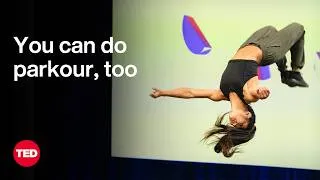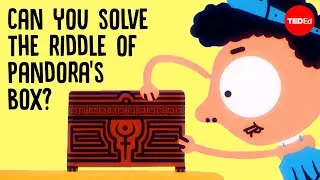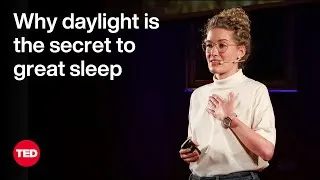請雙擊下方英文字幕播放視頻。
譯者: 育霆 熊
審譯者: Regina Chu
00:06
You may know that it takes light
a zippy eight minutes
0
6794
3606
你可能知道光只要短短八分鐘
00:10
to reach us from the surface of the Sun,
1
10400
2723
就能從太陽表面抵達我們這裡
00:13
so how long do you think it takes light
2
13123
1933
那你認為光從太陽的核心到表面
00:15
to travel from the Sun's core
to its surface?
3
15056
3397
需要多少時間呢?
00:18
A few seconds or a minute at most?
4
18453
3086
幾秒鐘或是最多一分鐘?
00:21
Well, oddly enough, the answer
is many thousands of years.
5
21539
4438
嗯,很奇怪地
答案是好幾萬年
00:25
Here's why.
6
25977
1346
以下解釋為什麼
00:27
Photons are produced by the nuclear
reactions deep in the core of our Sun.
7
27323
4816
光子在太陽很深的核中
透過核反應產生
00:32
As the photons flow out of the core,
they interact with matter and lose energy,
8
32139
5425
光子從核心噴出來後
與物質相互作用而失去能量
00:37
becoming longer wavelength forms of light.
9
37564
3398
變成波長較長的光波
00:40
They start out as gamma rays in the core,
10
40962
2675
它們在核心中
以伽瑪射線的形式出發
00:43
but end up as x-rays, ultraviolet
or visible light as they near the surface.
11
43637
6324
但最終在表面變成
X 射線、紫外線或可見光
00:49
However, that journey
is neither simple nor direct.
12
49961
4395
但是,光的旅程不簡單也不直接
00:54
Upon being born, each photon travels at
a speed of 300,000 kilometers per second
13
54356
7356
每個光子製造出來後
就會以每秒 30 萬公里的速度旅行
01:01
until it collides with a proton
and is diverted in another direction,
14
61712
4909
直到它碰撞到質子並轉向
01:06
acting like a bullet ricocheting off
of every charged particle it strikes.
15
66621
4922
像子彈一樣被每一個
它撞到的帶電粒子反彈
01:11
The question of how far this photon gets
from the center of the Sun
16
71543
3844
而光子從太陽中心
經過每個碰撞之後
01:15
after each collision
17
75387
1864
行經的距離有多長的問題
01:17
is known as the random walk problem.
18
77251
3081
被稱為隨機漫步問題
01:20
The answer is given by this formula:
19
80332
2254
答案可由以下算式解出
01:22
distance equals step size times the square
root of the number of steps.
20
82586
5560
距離等於一步長
乘以步數的平方根
01:28
So if you were taking a random walk
from your front door
21
88146
3052
所以如果你從你家大門
開始隨機漫步
01:31
with a one meter stride each second,
22
91198
2555
以每秒一步且步幅一公尺
01:33
it would take you a million steps
and eleven days
23
93753
4082
則你花費一百萬步和十一天的時間
01:37
just to travel one kilometer.
24
97835
2670
只能走一公里遠
01:40
So then how long does it take for a photon
generated in the center of the sun
25
100505
4852
而光子從太陽中心誕生
直到抵達我們這裡
01:45
to reach you?
26
105357
1956
需要多久呢?
01:47
We know the mass of the Sun
27
107313
1742
我們知道太陽的質量
01:49
and can use that to calculate the number
of protons within it.
28
109055
4039
可以用這個計算有多少質子在裡面
01:53
Let's assume for a second that all
the Sun's protons are evenly spread out,
29
113094
4884
我們暫時假設太陽
所有的質子都均勻攤開
01:57
making the average distance between them
about 1.0 x 10^-10 meters.
30
117978
6876
使得它們之間的平均距離約為
10 的負 10 次方公尺
02:04
To random walk the 690,000 kilometers
from the core to the solar surface
31
124854
6295
從核心到太陽表面
隨機漫步 69 萬公里
02:11
would then require 3.9 x 10^37 steps,
32
131149
6581
將需要 3.9 乘 10 的 37 次方步
02:17
giving a total travel time
of 400 billion years.
33
137730
4659
需要四千億年的總時間
02:22
Hmm, that can't be right.
34
142389
2273
嗯,這樣不對
02:24
The Sun is only 4.6 billion years old,
so what went wrong?
35
144662
4052
太陽只有 46 億歲
那什麼出錯了?
02:28
Two things:
36
148714
1541
有兩件事
02:30
The Sun isn't actually of uniform density
37
150255
2792
實際上太陽的密度並不均勻
02:33
and photons will miss quite a few protons
between every collision.
38
153047
5388
光子每次碰撞會錯過一些質子
02:38
In actuality, a photon's energy,
39
158435
2644
實際上,一個光子的能量
02:41
which changes over
the course of its journey,
40
161079
2632
會隨著它旅行的過程而改變
02:43
determines how likely it is
to interact with a proton.
41
163711
3493
因而決定它如何與質子相互作用
02:47
On the density question,
42
167204
1586
至於密度的問題
02:48
our models show that the Sun
has a hot core,
43
168790
2917
我們的模型顯示太陽有一個熱核
02:51
where the fusion reactions occur.
44
171707
2356
是核融合反應發生的地方
02:54
Surrounding that is the radiative zone,
45
174063
2490
它的周圍是輻射區
02:56
followed by the convective zone,
which extends all the way to the surface.
46
176553
4866
其次是對流區
就這樣一直延伸到表面
03:01
The material in the core
is much denser than lead,
47
181419
3577
核心的密度比鉛還要大得多
03:04
while the hot plasma near the surface
is a million times less dense
48
184996
4625
而靠近表面的熱電漿密度
則小了一百萬倍
兩者之間則是連續密度
03:09
with a continuum of densities in between.
49
189621
2761
03:12
And here's the photon-energy relationship.
50
192382
3188
這裡是光子與能量的關係
03:15
For a photon that carries
a small amount of energy,
51
195570
3168
相對於一個攜帶少量能量的光子
03:18
a proton is effectively huge,
52
198738
2614
質子其實非常大
03:21
and it's much more likely to cause
the photon to ricochet.
53
201352
3532
它更容易使光子被彈飛
03:24
And for a high-energy photon,
the opposite is true.
54
204884
3779
而對於高能光子,情況正好相反
03:28
Protons are effectively tiny.
55
208663
2032
質子相對來說非常微小
03:30
Photons start off at very high energies
56
210695
2827
與光子在太陽表面
被輻射出去時的能量相較
03:33
compared to when they're finally radiated
from the Sun's surface.
57
213522
3479
光子出發時的能量非常高
03:37
Now when we use a computer
and a sophisticated solar interior model
58
217001
5098
現在我們使用電腦
和一個複雜的太陽內部模型
03:42
to calculate the random walk equation
with these changing quantities,
59
222099
4365
用變數計算隨機漫步方程
03:46
it spits out the following number:
170,000 years.
60
226464
5972
它算出來的是以下數字:17 萬年
03:52
Future discoveries about the Sun
may refine this number further,
61
232436
4296
未來有關太陽的發現
可以進一步細化這個數字
03:56
but for now,
to the best of our understanding,
62
236732
2833
但是現在,盡我們的理解
03:59
the light that's hitting your eyes today
63
239565
2348
今天進入我們眼睛的光
04:01
spent 170,000 years pinballing its way
towards the Sun's surface,
64
241913
5649
花了 17 萬年
以彈珠台遊戲的方式到太陽表面
04:07
plus eight miniscule minutes in space.
65
247562
3051
加上在宇宙穿梭的微小 8 分鐘
04:10
In other words, that photon
began its journey two ice ages ago,
66
250613
5115
換句話說,光子在兩個
冰河時期前就開始了它的旅程
04:15
around the same time when humans
first started wearing clothes.
67
255728
4706
同一時間人類才剛開始穿衣服
New videos
關於本網站
本網站將向您介紹對學習英語有用的 YouTube 視頻。 您將看到來自世界各地的一流教師教授的英語課程。 雙擊每個視頻頁面上顯示的英文字幕,從那裡播放視頻。 字幕與視頻播放同步滾動。 如果您有任何意見或要求,請使用此聯繫表與我們聯繫。







